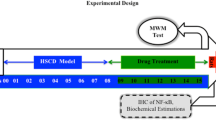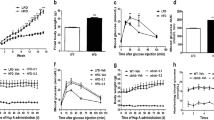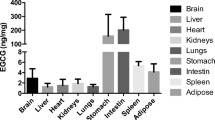Abstract
Mounting evidences have demonstrated that diet-induced obesity is associated with cognition impairment via increasing oxidative stress and inflammation in the brain. Atorvastatin (Ator, a HMG-CoA reductase inhibitor) is a cholesterol lowering drug. Studies have reported that Ator can ameliorate the development and progression of cognition impairment. Additionally, silent information regulator 1 (SIRT1) has been demonstrated to be beneficial in cognition impairment. However, the interaction between Ator and SIRT1 activation for cognition impairment remains unclear. This study aimed to identify a relationship between the use of Ator and cognition impairment induced by high-fat diet via Sirt1 activation. A total of 60 healthy male C57BL/6J mice were purchased and then divided into 6 groups, including normal diet group (control), a high-fat diet group (40%HFD, 40% energy from fat), a model group (60%HFD, 60% energy from fat), and model group treated with different doses of Ator (high-dose (80 mg), moderate-dose (40 mg), and low-dose (20 mg) groups). All interventions took place for 7 months. Metabolic phenotypes were characterized for body weight and analysis of serum lipid level. The level of cognition development was examined by Morris water maze (MWM) approach and novel object recognition test (NORT); besides, the expression of Creb1, Gap-43, BDNF, CaMKII, and ERKs of frontal cortex and hippocampus was determined by reverse transcription polymerase chain reaction (RT-PCR). Then, the levels of factors related to inflammation (TNF-a, IL-1β, HMGB1 and IL-6) and oxidation stress (SOD, MDA, CAT and GSH-Px) were assessed using commercially available kits. Finally, SIRT1 and its downstream molecules (Ac-FoxO1, Ac-p53, Ac-NF-κB, Bcl-2 and Bax) were evaluated by Western blot analysis. Compared with the 60% HFD group, body weight and serum lipid levels were significantly decreased in the Ator treated groups. The results of MWM and NORT, as well as the levels of Creb1, Gap-43, BDNF, CaMKII, and ERKs were markedly reversed in the moderate- and low-dose of Ator treated groups. Meanwhile, the expression of IL-1β, TNF-a, IL-6, HMGB1, and MDA was notably decreased, whereas the activity of SOD, CAT, and GSH-Px was increased. It was also revealed that the expression of SIRT1 was remarkably unregulated, the level of Bcl-2 was upregulated, and the content of Ac-FoxO1, Ac-p53, Ac-NF-κB, and Bax was downregulated in the moderate- and low-dose of Ator. Furthermore, results showed that the effect of moderate-dose of Ator was significantly greater than the low-dose of Ator. However, these effects were not observed in the high-dose of Ator. Our results showed that moderate- and low-dose of Ator can significantly attenuate cognition impairment induced by HFD through its antioxidant and anti-inflammatory functions related to SIRT1 activation.














Similar content being viewed by others
References
Traill WB, Mazzocchi M, Shankar B et al (2014) Importance of government policies and other influences in transforming global diets. Nutr Rev 72:591–604
Martin KA, Mani MV, Mani A (2015) New targets to treat obesity and the metabolic syndrome. Eur J Pharmacol 763:64–74
Keihani S, Hosseinpanah F, Barzin M et al (2015) Abdominal obesity phenotypes and risk of cardiovascular disease in a decade of follow-up: the Tehran Lipid and Glucose Study. Atherosclerosis 238(2):256–263
Kullmann S, Heni M, Hallschmid M et al (2016) Brain insulin resistance at the crossroads of metabolic and cognitive disorders in humans. Physiol Rev 96:1169–1209
World Alzheimer Report (2015) The global impact of dementia/Alzheimer’s disease International. http://www.alz.co.uk/research/world-report-2015
Norton S, Matthews FE, Barnes DE et al (2014) Potential for primary prevention of Alzheimer’s disease: an analysis of population-based data. Lancet Neurol 13:819–828
Hao S, Dey A, Yu X et al (2016) Dietary obesity reversibly induces synaptic stripping by microglia and impairs hippocampal plasticity. Brain Behav Immun 51:230–239
Moreira EL, de Oliveira J, Engel DF et al (2014) Hypercholesterolemia induces short-term spatial memory impairments in mice: up-regulation of acetylcholinesterase activity as an early and causal event. J Neural Transm (Vienna) 121(4):415–426
Alosco ML, Gunstad J (2014) The negative effects of obesity and poor glycemic control on cognitive function: a proposed model for possible mechanisms. Curr Diab Rep 14(6):495
Miller AA, Spencer SJ (2014) Obesity and neuroinflammation: a pathway to cognition impairment. Brain Behav Immun 42:10–21
Haines BE, Wiest O, Stauffacher CV (2013) The increasingly complex mechanism of HMG-CoA reductase. Acc Chem Res 46:2416–2426
Everett BM, Smith RJ, Hiatt. WR (2015) Reducing LDL with PCSK9 inhibitors—the clinical benefit of lipid drugs. N Engl J Med 373:1588–1591
Lilly SM, Mortensen EM, Frei CR et al (2014) Comparison of the risk of psychological and cognitive disorders between persistent and nonpersistent statin users. Am J Cardiol 114:1035–1039
Reis PA, Alexandre PCB, D’Avila JC et al (2017) Statins prevent cognition impairment after sepsis by reverting neuroinflammation, and microcirculatory/endothelial dysfunction. Brain Behav Immun 60:293–303
Lu D, Goussev A, Chen J et al (2004) Atorvastatin reduces neurological deficit and increases synaptogenesis, angiogenesis, and neuronal survival in rats subjected to traumatic brain injury. J Neurotrauma 21(1):21–32
Boimel M, Grigoriadis N, Lourbopoulos A et al (2009) Statins reduce the neurofibrillary tangle burden in a mouse model of tauopathy. J Neuropathol Exp Neurol 68(3):314–325
Banach M, Rizzo M, Nikolic D et al (2017) Intensive LDL-cholesterol lowering therapy and neurocognitive function. Pharmacol Ther 170:181–191
U.S. Food and Drug Administration (2012) FDA Consumer Health Information: FDA expands advice on statin risks. http://www.fda.gov/consumer
Hammer GP, du Prel J-B, Blettner M (2009) Avoiding bias in observational studies: part 8 in a series of articles on evaluation of scientific publications. Dtsch Arztebl Int 106:664–668
Okeahialam BN, Isiguzoro I (2012) Statin related memory dysfunction in a Nigerian woman: a case report. Curr Drug Saf 7:33–34
Orth M, Bellosta S (2012) Cholesterol: Its regulation and role in central nervous system disorders. Cholesterol 2012:292598
van Vliet P (2012) Cholesterol and late-life cognitive decline. J Alzheimers Dis 30(Suppl 2):S147–S162
Kobalava ZD, Villevalde SV, Vorobyeva MA (2017) Effects of high-dose statin therapy on cognitive functions and quality of life in very high cardiovascular risk patients. Kardiologiia 57(9):34–41
Bonda DJ, Lee H, Camins A et al (2011) The sirtuin pathway in ageing and Alzheimer disease: mechanistic and therapeutic considerations. Lancet Neurol 10:275–279
Sathya M, Moorthi P, Premkumar P et al (2017) Resveratrol intervenes cholesterol- and isoprenoid-mediated amyloidogenic processing of AβPP in Familial Alzheimer’s disease. J Alzheimer’s Dis 60:S3–S23
Turner RS, Thomas RG, Craft S et al (2015) A randomized, double-blind, placebo-controlled trial of resveratrol for Alzheimer disease. Neurology 85:1383–1391
Kreusser MM, Backs J (2014) Integrated mechanisms of CaMKII-dependent ventricular remodeling. Front Pharmacol 5:36
Sawda C, Moussa C, Turner RS (2017) Resveratrol for Alzheimer’s disease. Ann N Y Acad Sci 1403(1):142–149
Treviño S, Aguilar-Alonso P, Flores Hernandez JA et al (2015) A high calorie diet causes memory loss, metabolic syndrome and oxidative stress into hippocampus and temporal cortex of rats. Synapse 69(9):421–433
Rao R, Tkac I, Unger EL et al (2013) Iron supplementation dose for perinatal iron deficiency differentially alters the neurochemistry of the frontal cortex and hippocampus in adult rats. Pediatr Res 73(1):31–37
Latchney SE, Masiulis I, Zaccaria KJ et al (2014) Developmental and adult GAP-43 deficiency in mice dynamically alters hippocampal neurogenesis and mossy fiber volume. Dev Neurosci 36:44–63
Cortese GP, Barrientos RM, Maier SF et al (2011) Aging and a peripheral immune challenge interact to reduce mature brain-derived neurotrophic factor and activation of TrkB, PLCgamma1, and ERK in hippocampal synaptoneurosomes. J Neurosci 31(11):4274–4279
Jiang X, Chai GS, Wang ZH et al (2015) CaMKII-dependent dendrite ramification and spine generation promote spatial training-induced memory improvement in a rat model of sporadic Alzheimer’s disease. Neurobiol Aging 36(2):867–876
Xie H, She GM, Wang C et al (2015) The gender difference in effect of sevoflurane exposure on cognitive function and hippocampus neuronal apoptosis in rats. Eur Rev Med Pharmacol Sci 19(4):647–657
Lee B, Sur B, Shim J et al (2014) Acupuncture stimulation improves scopolamine-induced cognition impairment via activation of cholinergic system and regulation of BDNF and CREB expressions in rats. BMC Complement Altern Med 14:338
Cordner ZA, Tamashiro KL (2015) Effects of high-fat diet exposure on learning & memory. Physiol Behav 152(Pt B):363–371
Diba R, Mohaddes G, Mirzaie Bavil F et al (2018) Protective effects of troxerutin on maternal high-fat diet-induced impairments of spatial memory and apelin in the male offspring. Iran J Basic Med Sci 21(7):682–687
Alzoubi KH, Mayyas FA, Mahafzah R et al (2018) Melatonin prevents memory impairment induced by high-fat diet: role of oxidative stress. Behav Brain Res 336:93–98
Jayaraman A, Lent-Schochet D, Pike CJ (2014) Diet-induced obesity and low testosterone increase neuroinflammation and impair neural function. J Neuroinflamm 11:162
Yang J, Huang C, Yang J et al (2010) Statins attenuate high mobility group box-1 protein induced vascular endothelial activation: a key role for TLR4/NF-κB signaling pathway. Mol Cell Biochem 345:189–195
Hu H, Zhou S, Liu Q (2015) The magic and mystery of statins in aging: The potent preventive and therapeutic agent. Int J Cardiol 187:58–59
Kumar A, Babu GN (2010) In vivo neuroprotective effects of peripheral kynurenine on acute neurotoxicity induced by glutamate in rat cerebral cortex. Neurochem Res 35(4):636–644
Dursun E, Gezen-Ak D, Hanağası H et al (2015) The interleukin 1 alpha, interleukin 1 beta, interleukin 6 and alpha-2-macroglobulin serum levels in patients with early or late onset Alzheimer’s disease, mild cognition impairment or Parkinson’s disease. J Neuroimmunol 283:50–57
Osso LA, Chan JR (2015) Astrocytes underlie neuroinflammatory memory impairment. Cell 163:1574–1576
Xu M, Zhou GM, Wang LH et al (2016) Inhibiting High-Mobility Group Box 1 (HMGB1) attenuates inflammatory cytokine expression and neurological deficit in ischemic brain injury following cardiac arrest in rats. Inflammation 39(4):1594–1602
Wei H, Zou H, Sheikh AM et al (2011) IL-6 is increased in the cerebellum of autistic brain and alters neural cell adhesion, migration and synaptic formation. J Neuroinflamm 8:52
Tucsek Z, Toth P, Sosnowska D et al (2014) Obesity in aging exacerbates blood-brain barrier disruption, neuroinflammation, and oxidative stress in the mouse hippocampus: effects on expression of genes involved in beta-amyloid generation and Alzheimer’s disease. J Gerontol A 69(10):1212–1226
Luo Y, Yue W, Quan X et al (2015) Asymmetric dimethylarginine exacerbates Aβ-induced toxicity and oxidative stress in human cell and Caenorhabditis elegans models of Alzheimer disease. Free Radic Biol Med 79:117–126
Lu P, Mamiya T, Lu LL et al (2009) Silibinin prevents amyloid beta peptide-induced memory impairment and oxidative stress in mice. Br J Pharmacol 157(7):1270–1277
Kim M, Paik JK, Kang R et al (2013) Increased oxidative stress in normal-weight postmenopausal women with metabolic syndrome compared with metabolically healthy overweight/obese individuals. Metabolism 62(4):554–560
Ledreux A, Wang X, Schultzberg M et al., Detrimental effects of a high fat/high cholesterol diet on memory and hippocampal markers in aged rats. Behav Brain Res 312:294–304
de Kreutzenberg SV, Ceolotto G, Papparella I et al (2010) Downregulation of the longevity-associated protein sirtuin 1 in insulin resistance and metabolic syndrome: potential biochemical mechanisms. Diabetes 59:1006–1015
Herskovits AZ, Guarente L (2014) SIRT1 in Neurodevelopment and Brain Senescence. Neuron 81:471–483
Du G, Song Y, Zhang T et al (2014) Simvastatin attenuates TNFαinduced apoptosis in endothelial progenitor cells via theupregulation of SIRT1. Int J Mol Med 34:177–182
Kilic U, Gok O, Elibol-Can B et al (2015) Efficacy of statins on sirtuin 1 and endothelial nitric oxide synthase expression: the role of sirtuin 1 gene variants in human coronary atherosclerosis. Clin Exp Pharmacol Physiol 42(4):321–330
Singh I, Samuvel DJ, Choi S et al (2018) Combination therapy of lovastatin and AMP-activated protein kinase activator improves mitochondrial and peroxisomal functions and clinical disease in experimental autoimmune encephalomyelitis model. Immunology 154(3):434–451
Hu HJ, Zhou SH, Liu QM (2015) The magic and mystery of statins in aging: The potent preventive and therapeutic agent. Int J Cardiol 187:58–59
Sirtori CR (2014) The pharmacology of statins. Pharmacol Res 88:3–11
Pandit AK, Kumar P, Kumar A et al (2016) High-dose statin therapy and risk of intracerebral hemorrhage: a meta-analysis. Acta Neurol Scand 134:22–28
Priti K, Agrawal A, Ranwa BL (2017) High versus low dose statin therapy in Indian patients with acute ST-segment elevation myocardial infarction undergoing thrombolysis. Indian Heart J 69:453–457
Oh J, Kang S, Hong N et al (2014) Effect of high-dose statin loading on biomarkers related to inflammation and renal injury in patients hospitalized with acute heart failure. CIRC J 78:2447–2454
Beydoun MA, Beason-Held LL, Kitner-Triolo MH et al (2011) Statins and serum cholesterol’s associations with incident dementia and mild cognition impairment. J Epidemiol Community Health 65:949–957
McGuinness B, Craig D, Bullock R et al (2016) Statins for the prevention of dementia. Cochrane Database Syst Rev 2(2):CD003160
Clarke AT, Johnson PCD, Hall GC et al (2016) High dose atorvastatin associated with increased risk of significant hepatotoxicity in comparison to simvastatin in UK GPRD Cohort. PLoS ONE 11:e0151587
Acknowledgements
This study was supported by the National Natural Science Foundation of China (Grant No. 81771258).
Author information
Authors and Affiliations
Corresponding author
Ethics declarations
Conflict of interest
The authors declare that there is no conflict of interest regarding the publication of this article.
Additional information
Publisher’s Note
Springer Nature remains neutral with regard to jurisdictional claims in published maps and institutional affiliations.
Rights and permissions
About this article
Cite this article
Liu, H., Yang, J., Wang, K. et al. Moderate- and Low-Dose of Atorvastatin Alleviate Cognition Impairment Induced by High-Fat Diet via Sirt1 Activation. Neurochem Res 44, 1065–1078 (2019). https://doi.org/10.1007/s11064-019-02738-z
Received:
Revised:
Accepted:
Published:
Issue Date:
DOI: https://doi.org/10.1007/s11064-019-02738-z




